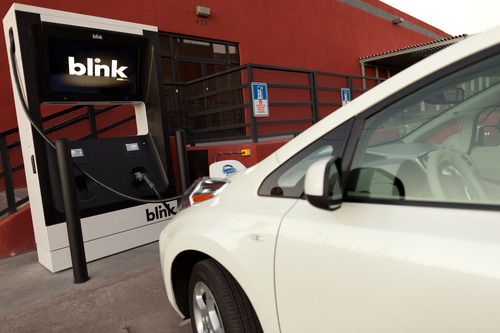The Blink Network has gone to kilowatt-hour pricing, in states where it’s allowed. The electric car charging network, now owned by the CarCharging Group, says this move is being done to become more competitive, by adapting to changes in the market. Another change that will be greatly appreciated is a switch to more granular time-based charging in states that do not allow kilowatt-hour pricing.
Until now, the Blink Network charged a $1 per hour fee, at 1 hour intervals. A session that lasted 1 hour 2 minutes would incur a $2 dollar charge, causing lots of anger among Blink members.
Other charging station networks, like SemaCharge and most of the ChargePoint stations, have a $0.49 per kilowatt-hour fee for using charging stations.
The BlinkNetwork will use kilowatt-hour pricing in states which allow it. Some states have laws making it impossible for retail “sale” of electricity by any entity other than an electrical utility company. It’s not practical for a charging station company to become an electrical utility, what they (Blink, ChargePoint, etc) chose to do instead is institute a time-based fee. That way the charging network is not selling electricity, but selling the service of accessing a charging station.
Blink will switch to kilowatt-hour pricing in these states: California, Colorado, Florida, Hawaii, Illinois, Maryland, Minnesota, New York, Oregon, Utah, Virginia, and Washington, along with the District of Columbia. The fee for Level 2 charging will range from $0.39 to $0.79 per kWh depending on state rules, and an individuals membership status with the Blink Network. The fee for DC Fast Charging will range from $0.49 to $0.69 per kWh.
In other states the granularity for time-based fees will decrease from 1 hour intervals to 30 seconds. That means the 1 hour 2 minute session I mentioned earlier will be charged an actual 1 hour 2 minutes, not for 2 hours. Yipee.
Fees for Level 2 charging stations owned by Blink and operated on the Blink Network in non-kWh eligible states will range from $0.04 to $0.06 per minute, depending on membership status. Fees for DCFC chargers owned by Blink and operated on the Blink Network in non-kWh eligible states will range from $6.99 – $9.99 per session, depending on membership status.
The switch to kilowatt-hour pricing seems to have been pushed by the parent of Blink, the CarCharging Group. The press release has this to say: “CarCharging is a proponent of kWh pricing because it is usage-based and EV drivers pay fees based on the actual amount of power consumed during the charging session rather than the amount of time that the car remains plugged into the station.”
Let me say that I don’t quite agree. I appreciate that kilowatt-hour pricing more accurately charges those of us with cars which have more powerful chargers. But, I believe charging station use should have a time-based fee as well as a kilowatt-hour based fee.
Why? Charging stations at this time are a rare commodity. EV owners, judging from my observations, need an incentive to move their car when charging is finished. I frequently see EV’s at a charging station, perhaps plugged in, sometimes not, but the charging session is finished. That EV owner is blocking access to the station and is perpetuating bad etiquette.
A time-based fee is a great incentive to move the car quickly when charging is finished.
However time-based fee’s miss part of the charging network cost structure, so it’s important to the charging network to charge by the kilowatt-hour. Some of the EV’s out there consume 3 kilowatts while charging, others consume 6, and others consume more. My car can consume 8 or 9 kilowatts depending on charging station capacity. An EV consuming 6 kilowatts costs twice the electricity bill for the charging network than one consuming 3 kilowatts.
Yes, I understand why CarCharging Group wants kilowatt-hour pricing. But is that the best model for EV owners?
Either way, this is a very positive move for the Blink Network to take. It shows that the CarCharging Group is serious about revamping the Blink network operation rather than just let it wither away. What will be more help is if they make sure Blink stations are, um, on the Blink less often. (more reliable, that is)
The change begins today, September 2, 2014
- Highway design could decrease death and injury risk, if “we” chose smarter designs - March 28, 2015
- GM really did trademark “range anxiety”, only later to abandon that mark - March 25, 2015
- US Government releases new regulations on hydraulic fracturing, that some call “toothless” - March 20, 2015
- Tesla Motors magic pill to solve range anxiety doesn’t quite instill range confidence - March 19, 2015
- Update on Galena IL oil train – 21 cars involved, which were the supposedly safer CP1232 design - March 7, 2015
- Another oil bomb train – why are they shipping crude oil by train? – Symptoms of fossil fuel addiction - March 6, 2015
- Chevron relinquishes fracking in Romania, as part of broader pull-out from Eastern European fracking operations - February 22, 2015
- Answer anti- electric car articles with truth and pride – truth outshines all distortions - February 19, 2015
- Apple taking big risk on developing a car? Please, Apple, don’t go there! - February 16, 2015
- Toyota, Nissan, Honda working on Japanese fuel cell infrastructure for Japanese government - February 12, 2015











